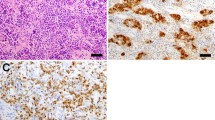Abstract
Purpose
We set out to describe the modern day management of Lymphocytic hypophysitis (LH) with respect to its diagnosis, treatment and long-term endocrine and visual outcomes. We deliberately included patients with a clinical diagnosis of LH and compared them with those with a histological diagnosis following surgery.
Methods
A multi-centre observational study was performed. Twenty-two patients were included and studied over a mean follow-up period of 8.6 years (range 4–26 years).
Results
Patients presented with headache (N = 15; 68 %), visual field disturbances (N = 7; 32 %) or a combination of these symptoms (N = 5; 23 %). The time lag between onset of symptoms and diagnosis was <1 month, 1–6 months or >6 months in approximately a third of the patients each, respectively. In two-thirds of the patients (N = 14) LH was diagnosed based on their clinical, biochemical and radiological findings. The surgical cohort (N = 8) was statistically more likely to have presented with larger lesions, with suprasellar extension and greater visual field defects. During follow-up there was improvement in headaches and visual symptoms, but the rate of hypopituitarism as reflected by the need for on-going pituitary hormone replacement persisted. At the 1, 5 and 10 year follow-up there was no significant difference between the medically and surgically managed cohorts in terms of ongoing symptomatology or need for pituitary hormone replacement.
Conclusions
In the modern era, most patients with LH are diagnosed by non-surgical means and managed medically. There remains a significant time lag between the onset of symptoms and the eventual diagnosis of LH. Despite the considerable morbidity attached to LH, overall prognosis is good.



Similar content being viewed by others
References
Cheung CC, Ezzat S, Smyth HS et al (2001) The spectrum and significance of primary hypophysitis. J Clin Endocrinol Metab 86(3):1048–1053
Caturegli P, Newschaffer C, Olivi A et al (2005) Autoimmune hypophysitis. Endocr Rev 26(5):599–614
Buxton N, Robertson I (2001) Lymphocytic and granulocytic hypophysitis: a single centre experience. Br J Neurosurg 15(3):242–245
De Bellis A, Ruocco G, Battaglia M et al (2008) Immunological and clinical aspects of lymphocytic hypophysitis. Clin Sci (Lond) 114(6):413–421
Honegger J, Fahlbusch R, Bornemann A et al (1997) Lymphocytic and granulomatous hypophysitis: experience with nine cases. Neurosurgery 40(4):713–723
Gutenberg A, Hans V, Puchner MJA et al (2006) Primary hypophysitis: clinical-pathological correlations. Eur J Endocrinol 155(1):101–107
Juszczak A, Gupta A, Karavitaki N et al (2012) Ipilimumab: a novel immunomodulating therapy causing autoimmune hypophysitis: a case report and review. Eur J Endocrinol 167(1):1–5
Faje AT, Sullivan R, Lawrence D et al (2014) Ipilimumab-induced hypophysitis: a detailed longitudinal analysis in a large cohort of patients with metastatic melanoma. J Clin Endocrinol Metab 99(11):4078–4085
Luke JJ, Ott PA (2015) PD-1 pathway inhibitors: the next generation of immunotherapy for advanced melanoma. Oncotarget 6(6):3479–3492
Honegger J, Schlaffer S, Menzel C et al (2015) Diagnosis of primary hypophysitis in Germany. J Clin Endocrinol Metab 100(10):3841–3849
Bellastella A, Bizzarro A, Coronella C et al (2003) Lymphocytic hypophysitis: a rare or underestimated disease? Eur J Endocrinol 149(5):363–376
Kristof RA, Van Roost D, Klingmuller D et al (1999) Lymphocytic hypophysitis: non-invasive diagnosis and treatment by high dose methylprednisolone pulse therapy? J Neurol Neurosurg Psychiatry 67(3):398–402
Honegger J, Buchfelder M, Schlaffer S et al (2015) Treatment of primary hypophysitis in Germany. J Clin Endocrinol Metab 100(9):3460–3469
Caturegli P (2007) Autoimmune hypophysitis: an underestimated disease in search of its autoantigen(s). J Clin Endocrinol Metab 92(6):2038–2040
Khare S, Varsha SJ, Sweta RB et al (2015) Primary (autoimmune) hypophysitis: a single centre experience. Pituitary 18(1):16–22
Acknowledgments
We would like to thank Prof. Julian Davies (CMFT), Prof. Peter Trainer (The Christie) and Dr. Richard Bell (Stepping Hill hospital) for contributing patients for this project. We would also like to thank Dr. Kelly Cheer (The Christie), Dr. Raj N Mudaliar (CMFT) and Dr. Richard Bell (Stepping Hill hospital) for collecting data for some of the patients. Finally, we would like to thank Ms. Tina Karabatsou (SRFT) and Dr. Annice Mukherjee (SRFT) for their valuable contribution in the multi-disciplinary discussions regarding these patients and Mr. Nikolas Economides for providing statistical advice.
Author contributions
AK has collected and analysed the data and wrote the first draft of the manuscript. TK has conceived the idea and revised the manuscript. KG contributed to data analysis and revision of the manuscript.
Author information
Authors and Affiliations
Corresponding author
Ethics declarations
Conflict of interest
The authors declare that there is no conflict of interest that could be perceived as prejudicing the impartiality of the research reported.
Ethical standards
The study was approved by the Caldicott Guardian of our institution and complied with the ICH Harmonized Tripartite Guidelines for Good Clinical Practice, the Declaration of Helsinki and local laws. All researchers had full access to all of the data in the study.
Rights and permissions
About this article
Cite this article
Kyriacou, A., Gnanalingham, K. & Kearney, T. Lymphocytic hypophysitis: modern day management with limited role for surgery. Pituitary 20, 241–250 (2017). https://doi.org/10.1007/s11102-016-0769-3
Published:
Issue Date:
DOI: https://doi.org/10.1007/s11102-016-0769-3




